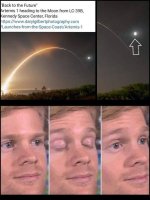ArlyA
Super Star Member
- Joined
- Mar 18, 2016
- Messages
- 12,343
- Tractor
- Outlander1000 6x6, Ego lawn mower and shopping for tractor
hubble and webb looking at threse very distant galaxies.
-----------------------------------------------------------------

 www.yahoo.com
www.yahoo.com
Fri, November 11, 2022 at 3:54 PM·3 min read

The Hubble Space Telescope orbits Earth and studies the universe in gorgeous detail.NASA
The star died more than 11 billion years ago, when the universe was less than a fifth of its current age of 13.8 billion years, but the light from its violent explosion just reached Earth. This is the first time astronomers have looked closely at a supernova so early in the universe's history.
Hubble watched the star collapse, expell its outer layers in a violent explosion, and then cool. Based on the supernova's brightness and how quickly it cooled, scientists calculated that this star was 500 times larger than the sun. The researchers' paper was published in the journal Nature on Wednesday.
-----------------------------------------------------------------

NASA's Hubble Space Telescope watched a distant star die, explode, and fade away in rare, colorful detail
A star 500 times larger than the sun collapsed, exploded, and died in a supernova 11 billion years ago. Hubble captured the whole colorful process.
NASA's Hubble Space Telescope watched a distant star die, explode, and fade away in rare, colorful detail
Morgan McFall-JohnsenFri, November 11, 2022 at 3:54 PM·3 min read

The Hubble Space Telescope orbits Earth and studies the universe in gorgeous detail.NASA
- NASA's Hubble Space Telescope captured a star that exploded and died 11 billion years ago.
- A massive galaxy cluster warped light from that supernova into three reflections.
- The three imprints show different colorful stages of the supernova explosion.
The star died more than 11 billion years ago, when the universe was less than a fifth of its current age of 13.8 billion years, but the light from its violent explosion just reached Earth. This is the first time astronomers have looked closely at a supernova so early in the universe's history.
Hubble watched the star collapse, expell its outer layers in a violent explosion, and then cool. Based on the supernova's brightness and how quickly it cooled, scientists calculated that this star was 500 times larger than the sun. The researchers' paper was published in the journal Nature on Wednesday.

